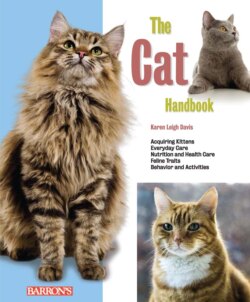Читать книгу The Cat Handbook - Karen Leigh Davis - Страница 15
На сайте Литреса книга снята с продажи.
How Cat Breeds Get Recognized
ОглавлениеA breed is a group of cats that share predictable characteristics in conformation, coat type, color, and temperament. Representatives of a particular breed are judged against a written standard of perfection, called the breed standard, which describes the common characteristics that are considered ideal for the breed.
Some breeds originate in a particular geographic region. The Turkish Angora and the Turkish Van are native to Turkey, as their names imply, and the Siamese cat originated in Siam, now called Thailand. But other breeds, like the Somali, may be named for regions to which they have no real ties. The Somali, often described as a longhaired Abyssinian, was named after modern-day Somalia, also known as Ethiopia, but the breed does not hail from that part of the world. Rather, the name was chosen symbolically, because Somalia borders the ancient African kingdom of Abyssinia, for which the Somali’s sister breed, the Abyssinian, was named. There again, the Abyssinian cat is named, not for its national origin (because no one is certain where the Aby really came from), but for the first such cat shown in England, a cat named Zula that was imported from Abyssinia around 1868.
New breeds, or new varieties and colors of existing ones, are being developed all the time. Some breeds, like the short-legged Munchkin, may begin as spontaneous genetic mutations, while others are created by crossbreeding established breeds. For example, the snub-nosed Exotic Shorthair, often called the “lazy man’s Persian” because of its short, low-maintenance coat, is the hybrid result of crossing two recognized breeds, the American Shorthair and the Persian.
Whatever the origin, the process of achieving recognition among the cat fancy for each new breed is typically a long and arduous task that can take years. The rules for acceptance vary among the cat fancy associations, but generally, proponents of a new breed start by applying for registration. Once cats are accepted for registration, a certain number have to be registered over a period of time before they can begin showing in noncompetitive, miscellaneous, or nonchampionship classes for experimental breeds and colors. Called Any Other Variety (AOV) or New Breeds and Colors (NBC), such classes are designed specifically for new breeds with new standards and for pedigreed cats that do not conform in some way, usually in color or coat length, to their current breed standard. In this prechampionship phase, new breeds hold provisional status and are judged according to a provisional standard. Proponents of the new breed must see that a certain number of cats continue to be registered and shown before full recognition is granted. Achieving the final step, championship status, requires the concerted effort of many breeders over a period of time before their cats become eligible to compete for points and awards in championship classes.
